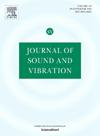高速磁悬浮车辆的失稳控制:电磁与波致失稳机制的相互作用
IF 4.3
2区 工程技术
Q1 ACOUSTICS
引用次数: 0
摘要
磁悬浮和较新的超级高铁技术是先进的运输系统,利用电磁悬浮消除轮轨摩擦。电磁悬浮具有固有的不稳定性,需要一种安全运行的控制策略,这在以前的磁悬浮环境下已经研究过了。然而,电磁不稳定性和另一种不稳定性机制之间的相互作用,即波致不稳定性,发生在高速车辆上,尚未被探索。两种不同的不稳定性机制之间的相互作用是本研究的重点。从实际的角度来看,本研究考察了磁悬浮车辆(例如,磁悬浮或超级高铁)在车辆速度和控制增益方面的稳定性。考虑到这一点,本研究适当地包括无限导轨,从而允许车辆速度影响系统稳定性。结果表明,在亚临界速度下,导轨的反作用力有助于抑制扰动,稳定系统,不稳定仅由不适当的电磁控制驱动。然而,在超临界速度下,波动引起的不稳定性极大地减小了稳定参数空间。本研究进一步提出了一种方法来区分每种不稳定机制对整体系统稳定性的贡献,这对于有效的缓解措施是重要的。研究结果表明,超过一定的超临界速度,波动引起的不稳定性主导了控制增益平面的大部分,控制策略仅在有限的区域有效。总之,该研究建议修改控制设计策略,因为仅仅关注通过控制最大化能量耗散可能引发波浪引起的不稳定。一种更有效的方法是通过避开有问题的振动频率来平衡能量耗散和避免激活波动引起的不稳定性。这些见解为改进控制策略提供了指导。本文章由计算机程序翻译,如有差异,请以英文原文为准。
Controlling instability of high-speed magnetically suspended vehicles: The interaction of the electromagnetic and wave-induced instability mechanisms
Maglev and the newer Hyperloop technologies are advanced transportation systems that eliminate wheel–rail friction using electromagnetic suspension/levitation. The electromagnetic suspension is inherently unstable and requires a control strategy for safe operation, which has been previously studied in the context of Maglev. However, the interaction between electromagnetic instability and another instability mechanism, known as wave-induced instability, occurring at high vehicle velocities, has not been explored. This interaction between two distinct instability mechanisms is the focus of this study. From a practical perspective, this study examines the stability of magnetically suspended vehicles (e.g., Maglev or Hyperloop) in relation to vehicle velocity and control gains. To account for this, this study properly includes the infinite guideway, thus allowing vehicle velocity to influence system stability. The results show that at sub-critical velocities, the guideway’s reaction force helps suppress perturbations and stabilize the system, with instability driven solely by improper electromagnetic control. However, at super-critical velocities, wave-induced instability drastically reduces the stable parameter space. This study further proposes a methodology to distinguish the contribution of each instability mechanism to the overall system stability, which is important for efficient mitigation measures. The findings reveal that beyond a certain super-critical velocity, wave-induced instability dominates much of the control-gain plane, with the control strategy effective in only limited regions. In conclusion, the study recommends revising control design strategies, as solely focusing on maximizing energy dissipation through control can trigger wave-induced instability. A more effective approach balances energy dissipation with avoiding the activation of wave-induced instability by steering clear of problematic vibration frequencies. These insights provide guidance for improving control strategies.
求助全文
通过发布文献求助,成功后即可免费获取论文全文。
去求助
来源期刊

Journal of Sound and Vibration
工程技术-工程:机械
CiteScore
9.10
自引率
10.60%
发文量
551
审稿时长
69 days
期刊介绍:
The Journal of Sound and Vibration (JSV) is an independent journal devoted to the prompt publication of original papers, both theoretical and experimental, that provide new information on any aspect of sound or vibration. There is an emphasis on fundamental work that has potential for practical application.
JSV was founded and operates on the premise that the subject of sound and vibration requires a journal that publishes papers of a high technical standard across the various subdisciplines, thus facilitating awareness of techniques and discoveries in one area that may be applicable in others.
 求助内容:
求助内容: 应助结果提醒方式:
应助结果提醒方式:


